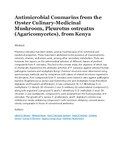Antimicrobial Coumarins from the Oyster Culinary-Medicinal Mushroom, Pleurotus ostreatus (Agaricomycetes), from Keny
Date
2016-10-05Author
Baraza, Lilechi D
Neser, Wekesa
Jackson, Korir Cheruiyot
Fredrick, Juma B
Dennis, Ochieno
Wairimu, Kamau R
Keya, Aggrey Osogo
Heydenreich, Matthias
Metadata
Show full item recordAbstract
Pleurotus ostreatus has been widely used as food because of its nutritional and medicinal properties. These have been attributed to the presence of macronutrients, minerals, vitamins, and amino acids, among other secondary metabolites. There are, however, few reports on the antimicrobial activities of different classes of purified compounds from P. ostreatus. This led to the current study, the objective of which was to chemically characterize the antibiotic activities of P. ostreatus against selected human pathogenic bacteria and endophytic fungi. Chemical structures were determined using spectroscopic methods and by comparison with values of related structures reported in the literature. Pure compounds from P. ostreatus were tested in vitro against pathogenic bacteria (Staphylococcus aureus and Escherichia coli) and endophytic fungi (Pencillium digitatum and Fusarium proliferatum). A new compound, (E)-5,7-dimethoxy-6-(3-methylbuta-1,3-dienyl)-2H-chromen-2-one (5-methoxy-(E)-suberodiene) (compound 2), along with ergosterol (compound 1) and 5,7-dimethoxy-6-(3-methylbut-2-enyl)-2H-chromen-2-one (toddaculin; compound 3), were isolated from the fruiting bodies of P. ostreatus. The growth of S. aureus, F. proliferatum, and P. digitatum colonies was inhibited in media containing compound 2, with minimum inhibitory concentrations closely comparable to those of conventional antibiotics.
URI
https://doi.org/10.1615/intjmedmushrooms.v18.i10.60https://pubmed.ncbi.nlm.nih.gov/27910758/
http://ir-library.mmust.ac.ke:8080/xmlui/handle/123456789/2271
Collections
- Gold Collection [1026]

